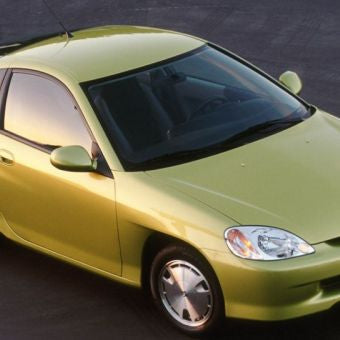Adidas Latest Footwear Announcement Featuring The First Mass Market 3D Printed Shoe, The FutureCraft4d Will Change The Shoe Industry Forever. (photo via Littlehonda.com)
Source: The Shoe That Will Change The Footwear Industry Forever
I recall in the 90s, in San Diego, walking around and noticing plug in terminals in front of Target, on college campuses, and in random locations throughout the city. These plug-in terminals were for electric cars. There was the Honda Insight that was available for people to purchase and I would see a few cars plugged in. By the late nineties those cars and terminals were gone.
Tesla has reinspired the fervor for the electric car and people have begun to really look at the models as a viable option. Is it affordable for the everyday person? Not quite. The models are more attainable via the Chevy Volt or Nissan Leaf, but overall the majority of the cars on the road are good old petroleum based beasts.
What does this have to do with 3D Printing and Footwear?
Footwear hasn’t really been revolutionized outside of the moment Jeff Johnson took a flip-flop, removed the thong and glued it between the upper and rubber outsole in his store in Los Angeles. A shoe has always been an upper, a midsole, outsole and insole. Asian manufacturing dominates the production and while there has been a call for a return to US Manufacturing, the reality is that it simply isn’t cost effective to return production to these shores. 3D Printing changes that… or does it. Consider it took 20 years for the electric car to become a niche market. People are set in their ways in how they approach shopping; especially when there is a premium price associated with a product.
Although 3D Printing offers an alternative that is faster and sustainable, and adidas, Nike, and Under Armour are all dabbling in the market with their own versions, will this really change the market?
Yes, but not for the reasons mentioned in the source article.
3D Printing will change the footwear industry because when a new technology is introduced it eventually is scaled down to the point that it’s affordable. As Tesla further develops their batteries for longer life, and more electric cars enter the used car market, and once gas stations begin to implement charging stations into gas based locations, more people will drive electric cars. The same will happen with footwear. The difference in the two business models is obvious. You won’t be able to 3D print a car and buy a Tesla battery and drive the thing around.
Footwear however will be a much easier entry point. 3D Printer cost has already been reduced 30%. That will still run the buyer around 270,000 dollars, (there are cheaper options at 20,000 and below but the quality would not be suitable for performance footwear) but the comparison to the electric car was the wrong one to make. This is an instance where the comparison should be to televisions. Consider this quote from a post in 2005: “Full-featured plasma TV’s with 50-inch screens that sold for $20,000 five years ago could edge close to $4,000 this season.” A 4K television which is a much more technically advanced product is now under 1,000 dollars from 6,000 dollars two years ago. In ten years we’ve moved from a $20,000 television to a 4K technical masterpiece for under $800.00.
3D Printing will see the same progress as additive manufacturing becomes more accessible. The wave of the future won’t derive from adidas Futurecraft or Under Armour Architech, it will be from the consumer who will decide that they want to interact with their footwear company on a more personal level.
3D Printing will change the game and the big shoe companies could potentially usher in their own demise as 3D Printing will make it easier for startup shoe companies to enter the game.
Sources:
http://www.zdnet.com/article/promising-trend-for-innovators-3d-printer-prices-are-falling/
#3DShoes #3DPrintedShoes #3DPrinted




